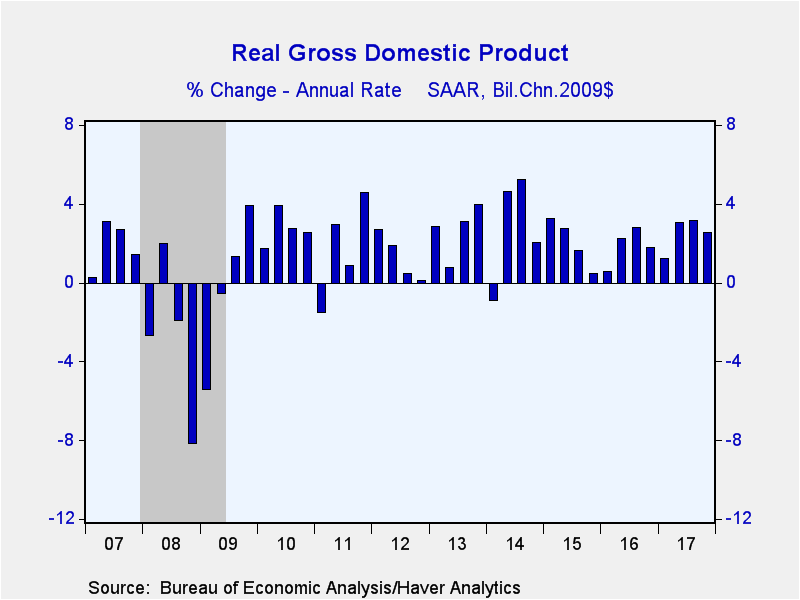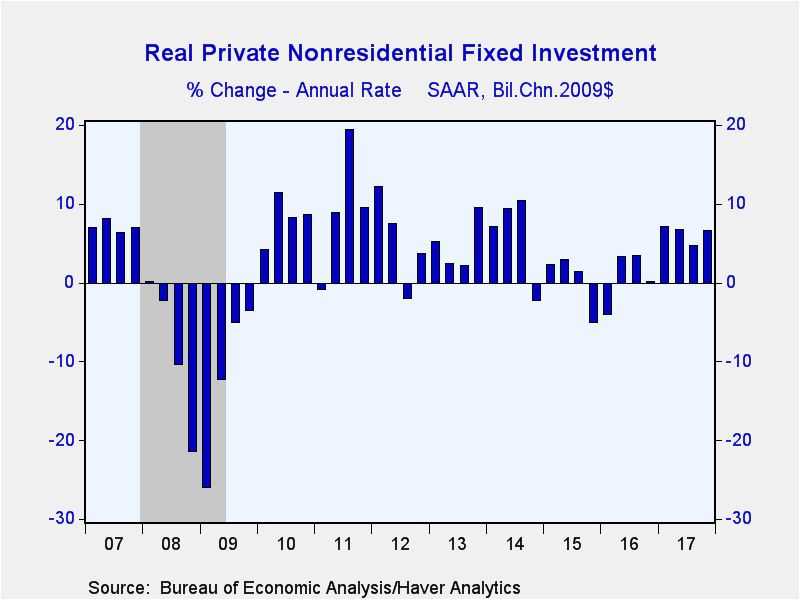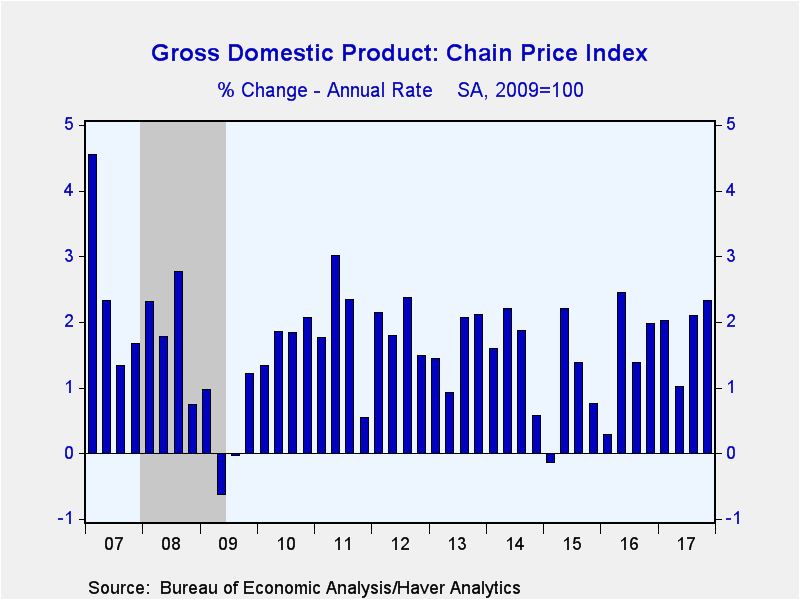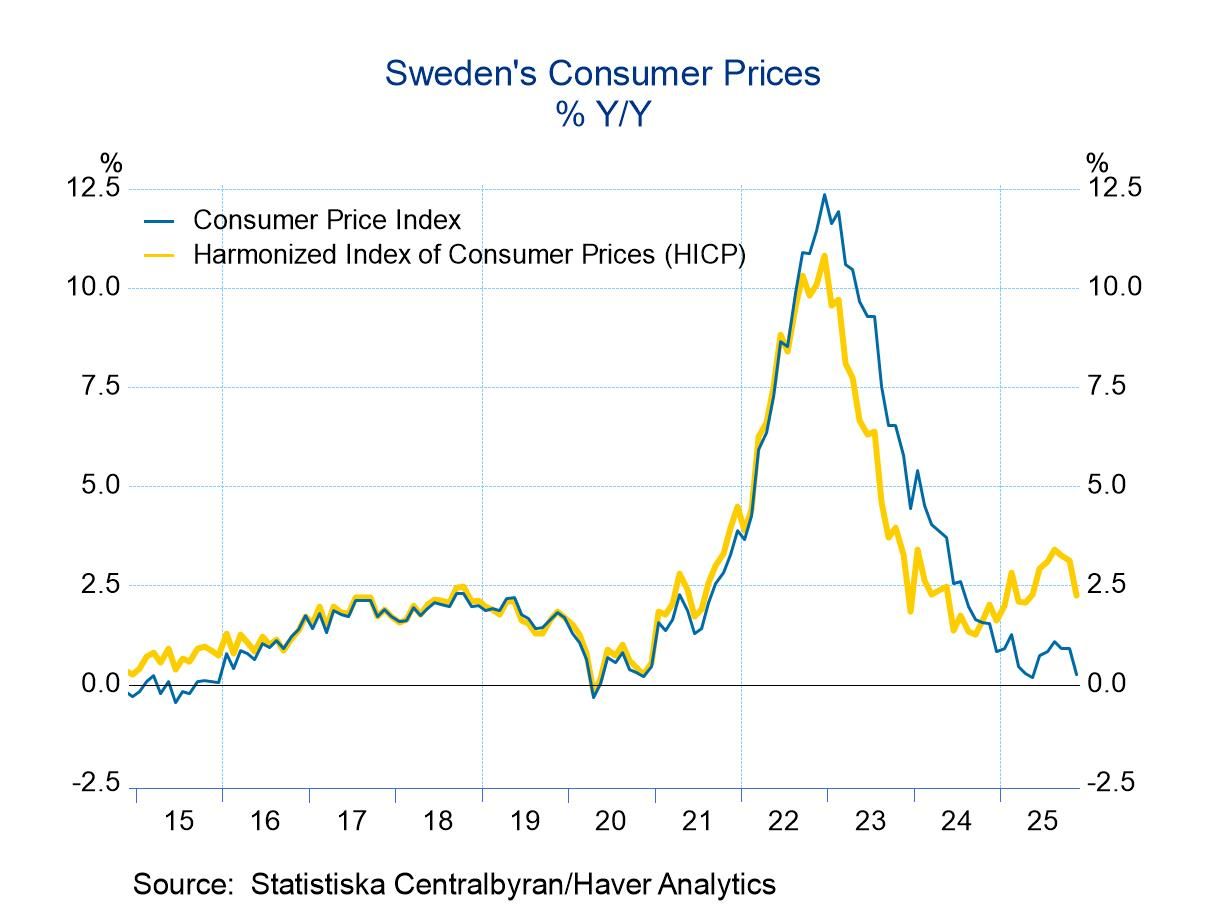 Global| Feb 28 2018
Global| Feb 28 2018U.S. GDP Growth Is Slightly Lessened
by:Tom Moeller
|in:Economy in Brief
Summary
In the second estimate of Q4'17 real GDP, the U.S. economy grew 2.5% (AR), slightly less than 2.6% estimated in the advance report. That followed a 3.2% Q3 rise and a 3.1% Q2 gain. Growth picked up, however, from Q4-to-Q4 to 2.5%, its [...]
In the second estimate of Q4'17 real GDP, the U.S. economy grew 2.5% (AR), slightly less than 2.6% estimated in the advance report. That followed a 3.2% Q3 rise and a 3.1% Q2 gain. Growth picked up, however, from Q4-to-Q4 to 2.5%, its quickest advance in three years. The quarterly gain matched expectations in the Action Economics Forecast Survey.
Inventories subtracted a slightly increased 0.7 percentage point from GDP growth last quarter. Deterioration in the foreign trade deficit subtracted an unchanged 1.1 percentage point. That subtraction was due to a 7.1% gain (5.0% y/y) in exports which was outpaced by a 14.0% rise (4.6% y/y) in imports.
Domestic final sales increased at an unrevised 4.3% rate (2.8% y/y), the quickest gain since Q3'14. Personal consumption expenditures grew 3.8% (2.8% y/y), the quickest rise since Q2'16. It reflected a 13.8% surge (7.4% y/y) in durable goods spending, prompted by an 18.9% jump (5.0% y/y) in spending on motor vehicles. That followed a 12.2% rise. Outlays on home furnishings & appliances strengthened 13.3% (8.9% y/y) after roughly 9.0% growth during the prior six months. Outlays on recreational products & motor vehicles surged 13.6% (9.4% y/y) following a 0.8% rise. Nondurable goods spending improved 4.3% (3.0% y/y) as outlays on apparel strengthened 10.8% (4.0% y/y) following declines in two of the prior three quarters. Food & beverage spending gained 7.3% (3.0% y/y), but outlays on gasoline & other energy products fell 3.7% (-1.1% y/y), the sixth quarterly decline in two years. Spending on services improved 2.1% (2.0% y/y) following a 1.1% rise. Spending on housing & utilities improved 2.1% (1.3% y/y) after falling in three of the prior four quarters. Health care spending strengthened 2.3% (2.5% y/y) after a 4.5% rise. Recreation services outlays eased 0.6% (+1.4% y/y). Food services & accommodations spending improved 0.9% (1.2% y/y) after a 1.9% rise.
Capital spending increased 6.6% (6.3% y/y), its fourth consecutive quarter of strong increase. Spending on equipment rose 11.8% (8.9% y/y) after a 10.8% gain. These increases have been accelerating for five quarters. Information processing equipment investment improved 8.9% (9.6% y/y) after a 10.8% gain while intellectual property product outlays rose 2.5% (4.3% y/y) after a 5.2% increase. Investment in industrial equipment gained 4.8% (7.9% y/y) following several quarters of strong increase. Investment in new structures improved 2.5% (4.0% y/y) following strength in two of the last three quarters and declines in 2016 and 2015.
Residential investment strengthened 13.1% (2.6% y/y) following declines in the prior two quarters.
Government spending improved 2.9% (0.7% y/y) after six straight quarters of near zero growth. Outlays by the federal government increased 3.3% (1.0% y/y) after two quarters of lesser growth. Defense outlays surged 5.6% (2.3% y/y), the strongest of three quarterly increases. Nondefense outlays were flat or declining for all of last year. State & local government spending improved 2.7% (0.5% y/y) in Q4, the only notable quarterly gain since Q1'16.
The GDP chain price index increased a little-changed 2.3% (1.9% y/y), the strongest rise since Q2'16. A 2.4% rise was expected. Growth in the PCE price index accelerated to 2.7% (1.7% y/y), the strongest rise since Q2'11. It was powered by a 3.2% jump (2.3% y/y) in the services price index. The business fixed investment price index rose 0.5%, with the 1.3% y/y increase following a slight decline in 2016. The residential investment price index gained 2.8% (3.4% y/y) following strength in three of the last four years. The government price index rose 2.9% y/y in 2017 after little gain during the prior two years.
The GDP figures can be found in Haver's USECON and USNA database. USNA contains virtually all of the Bureau of Economic Analysis' detail in the national accounts, including the integrated economic accounts and the recently added GDP data for U.S. Territories. The Action Economics consensus estimates can be found in AS1REPNA.
Less Food & Energy
Tom Moeller
AuthorMore in Author Profile »Prior to joining Haver Analytics in 2000, Mr. Moeller worked as the Economist at Chancellor Capital Management from 1985 to 1999. There, he developed comprehensive economic forecasts and interpreted economic data for equity and fixed income portfolio managers. Also at Chancellor, Mr. Moeller worked as an equity analyst and was responsible for researching and rating companies in the economically sensitive automobile and housing industries for investment in Chancellor’s equity portfolio. Prior to joining Chancellor, Mr. Moeller was an Economist at Citibank from 1979 to 1984. He also analyzed pricing behavior in the metals industry for the Council on Wage and Price Stability in Washington, D.C. In 1999, Mr. Moeller received the award for most accurate forecast from the Forecasters' Club of New York. From 1990 to 1992 he was President of the New York Association for Business Economists. Mr. Moeller earned an M.B.A. in Finance from Fordham University, where he graduated in 1987. He holds a Bachelor of Arts in Economics from George Washington University.












